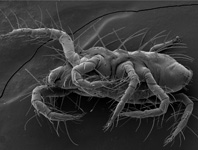Abstract
The morphological ontogeny of Liebstadia mongolica Bayartogtokh, 2001 is described and illustrated. The juveniles of this species are elongated and unpigmented. The larva has 12 pairs of gastronotal setae, and three of them are with excentrosclerites (c2, la, lp), the nymphs have 15 pairs, and five of them are with excentrosclerites (c2, la, lp, h2, h3). In all instars, solenidion ω1 on tarsus I is curved laterally, and is shorter than ω2.
References
Ayyildiz, N. & Luxton, M. (1989) New and unrecorded oribatid mites (Acari) from Turkey. Zoologischer Anzeiger, 222 (5–6), 294–300.
Bayartogtokh, B. (2001) Oribatid mites of Liebstadia (Acari: Oribatida: Scheloribatidae) from Mongolia, with notes on taxonomy of the genus. Journal of Natural History, 35, 1239–1260.
https://doi.org/10.1080/00222930152434490
Bayartogtokh, B. (2010) Oribatid mites of Mongolia (Acari: Oribatida). Russian Academy of Sciences, KMK Scientific Press Ltd., Moscow, 400 pp. [in Russian]
Berlese, A. (1883) Acari, Myriapoda et Scorpiones hucusque in Italia reperta. Vol. 9. No. 3. Sumptibus Auctoris, Portici, Padova, Fascicolo, 9, 1–10.
https://doi.org/10.5962/bhl.title.1589
Berlese, A. (1895) Acari, Myriapoda et Scorpiones hucusque in Italia reperta. Vol. 77. Sumptibus Auctoris, Portici, Padova, Fascicolo, 77, 1–10.
Berlese, A. (1908) Elenco di generi e specie nuovi di Acari. Redia, 5, 1–15.
Christov, V.V. (1970) New species of the oribatid mites in the soils of Tadzikistan. Oribatei and their role in the process of the soil formation, Vilnius, 1970, 155–160.
Csiszár, J. & Jeleva, M. (1962) Ori batid mites (Acari) from Bulgarian soils. Acta Zoologica Academiae Scientiarum Hungaricae, 8 (3–4), 273–301.
Fernandez, N.A. (1989) Oribates (Acariens) des lichens crustaces d’Argentine. I. Pirnodus cryophilus n. sp. Acarologia, 30 (3), 275–284.
Grandjean, F. (1949) Observation et conservation des tres petits Arthropodes. Bulletin du Muséum National d’Histoire Naturelle, Series 2, 3, 363–370.
Grandjean, F. (1953) Essai de classification des Oribates (Acariens). Bulletin de la Société zoologique de France, 78, 421–446.
Grandjean, F. (1956) Sur deux espéces nouvelles d’Oribates (Acariens) apparentées à Oripoda elongata Banks 1904. Archives de Zoologie expérimentale et générale, 93, 185–218.
Grandjean, F. (1958) Scheloribatidae et Oribatulidae (Acariens, Oribates). Bulletin du Muséum national d’histoire naturelle, Series 2, 30, 352–359.
Grandjean, F. (1963) Concernant Sphaerobates gratus, les Mochlozetidae et les Ceratozetidae (Oribates). Acarologia, 5, 284–305.
Hammer, M. (1977) Investigations on the oribatid fauna of North-West Pakistan. Det Kongelige Danske Videnskabernes Selskab, Biologiske Skrifter, 21 (4), 1–108.
Kulijev, K.A. (1968) New species and subspecies of oribatid mites from the forests of Azerbaijan. Uchenye zapiski Azerbaijan gosudarstvogo universiteta, Biology, 2, 84–101.
Łomnicki, A. (2010) Introduction to statistics for naturalists. PWN, Warsaw, 281 pp. [in Polish]
Michael, A.D. (1888) British Oribatidae. Vol. II. Ray Society, London, 321 pp. [pp. 337–657]
Miko, L. & Weigmann, G. (1996) Notes on the genus Liebstadia Oudemans, 1906 (Acarina, Oribatida) in Central Europe. Acta Musei Nationals Pragae, Historia Naturalis, B, 52 (1–4), 73–100.
Morell, M.J. (1987) Protoribates gallardoi n. sp. (Acari, Oribatei) de Cataluna (España). Redia, 70, 295–300.
Norton, R.A. (1983) Redefinition of Mochloribatula (Acari: Mochlozetidae) with new species, recombinations, and notes on plant associations. Acarologia, 24, 449–464.
Norton, R.A. & Behan-Pelletier, V.M. (2009) Suborder Oribatida. In: Krantz, G.W., Walter, D.E. (Eds.), A Manual of Acarology. 3rd Edition. Texas Tech University Press, Lubbock, pp. 430–564.
Norton, R.A. & Ermilov, S.G. (2014) Catalogue and historical overview of juvenile instars of oribatid mites (Acari: Oribatida). Zootaxa, 3833 (1), 1–132.
https://doi.org/10.11646/zootaxa.3833.1.1
Oudemans, A.C. (1906) Acarologische Aanteekeningen XXIV. Entomologische Berichten, 2, 96–101.
Sellnick, M. (1928) Formenkreis: Hornmilben, Oribatei. In: Brohmers, P., Ehrmann, P. & Ulmer, G. (Eds.), Die Tierwelt Mitteleuropas. 4 Lief. 3 (4). Quelle & Meyer, Leipzig, pp. 1–42.
Seniczak, S. (1980) The morphology of the juvenile stages of moss mites of the family Scheloribatidae Grandjean, 1953 (Acari, Oribatei), I. Acta Zoologica Cracoviensa, 24 (11), 487−500.
Seniczak, S. (1990) The morphology of juvenile stages of moss mites of the family Scheloribatidae (Acarida, Oribatida), II. Annales Zoologici, 43 (13), 299−308.
Seniczak, S., Ivan, O. & Seniczak, A. (2020) Morphological ontogeny of Damaeolus ornatissimus (Acari: Oribatida: Damaeolidae), with comments on Damaeolus Paoli. Systematic & Applied Acarology, 25 (3), 459–478.
https://doi.org/10.11158/saa.25.3.7
Seniczak, S., Kaczmarek, S. & Seniczak, A. (2017) Morphological ontogeny of Unguizetes ermilovi sp. nov. (Acari, Oribatida, Mochlozetidae) from Malaysia, and comments on Unguizetes Sellnick. Systematic & Applied Acarology, 22 (8), 1226–1242.
https://doi.org/10.11158/saa.22.8.7
Seniczak, S. & Seniczak, A. (2012) Differentiation of external morphology of Oribatulidae (Acari: Oribatida) in light of the ontogeny of three species. Zootaxa, 3184, 1–34.
http://dx.doi.org/10.11646/zootaxa.3184.1.1
Seniczak, S., Seniczak, A. & Chachaj, B. (2013) Morphology of juvenile stages of three species of Scheloribatidae (Acari: Oribatida). Annales Zoologici, 63 (1), 29–43.
https://doi.org/10.3161/000345413x666084
Seniczak, S., Seniczak, A. & Kaczmarek, S. (2018a) Morphological ontogeny of Peloribates longipilosus (Acari, Oribatida, Haplozetidae). Systematic & Applied Acarology, 23 (3), 521–531.
https://doi.org/10.11158/saa.23.3.10
Seniczak, S., Seniczak, A., Kaczmarek, S. & Marquardt, T. (2018b) Morphological ontogeny of Protoribates dentatus (Acari, Oribatida, Haplozetidae). Systematic & Applied Acarology, 23 (4), 613–627.
https://doi.org/10.11158/saa.23.4.4
Seniczak, S., Seniczak, A, Kaczmarek, S. & Żelazna, E. (2012) Systematic status of Oribatula Berlese, 1895 (Acari: Oribatida: Oribatulidae) in the light of the ontogeny of three species. International Journal of Acarology, 38 (8), 664–680.
https://doi.org/10.1080/01647954.2012.719030
Subías, L.S. (2004, updated in 2020) Listado sistemático, sinonímico y biogeográfico de los Ácaros Oribátidos (Acariformes, Oribatida) del mundo (1758−2002). Graellsia, 60 (Número Extraordinario), 3−305. [15ª actualización, 1–527 (accessed February 2020)]
https://doi.org/10.3989/graellsia.2004.v60.iextra.218
Vasiliu, N. & Calugar, M. (1973) Deux nouvelles espèces de la superfamille Oribatuloidea Woolley, 1956 (Acari: Oribatei). Revue Roumaine de Biologie, Série de Zoology, 18 (5), 325−332.
Weigmann, G. (2006) Hornmilben (Oribatida). In: Dahl, F. (Series Founder), Die Tierwelt Deutschlands. Part 76. Goecke & Evers, Keltern, pp. 1−520.
Willmann, C. (1951) Untersuchungen über die terrestrische Milbenfauna im pannonischen Klimagebiet Österreichs. Sitzungsberichte, Österreichische Akademie der Wissenschaften, Abteilung I, Biologie, Mineralogie, Erdkunde und verwandte Wissenschaften, Wien, 160 (1−2), 91−176.


